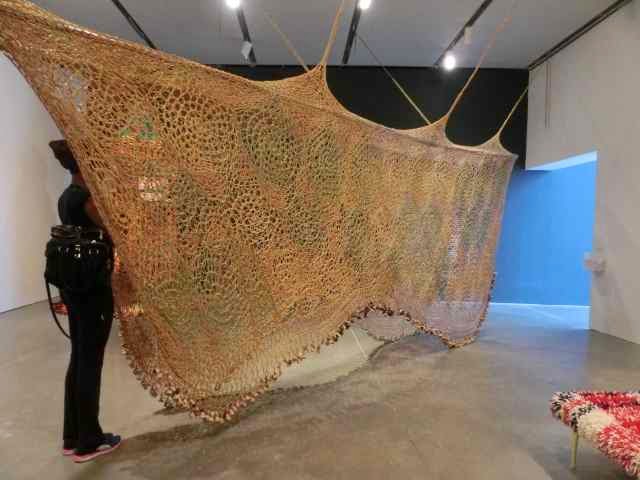It was in Boston that the trip became more about textiles. We did a day trip to Lowell. I had read about Lowell when I was looking at the history of the cotton industry as part of my research on cotton and its effect on the environment. Lowell was full of cotton mills and employed a lot of young women from very rural areas. The mill owners were keen that the girls were well looked after. There were boarding houses with strict matrons, evening lectures and a chance to earn money and be educated. they worked hard but it seemed like it was a lot healthier than the English cotton mills.
I loved Lowell and would have liked to have spent longer there. It was Autumn and the trees were starting to change color, and there was so much cotton history to explore.
We went to the American Textile History Museum which had a touring section of the Fiberarts Exhibition on display while we were there.
 |
| Gigantic looms which still work |
I love this black and white woven bedspread and wonder how I could translate this into cloth.
We also went to the New England Quilt Museum which I found a little disappointing but I think that is because I am not a traditionalist. It had some nice costumes and some of the fabrics were great. I'm sure if I lived there, I would use the library. They had a sale of second hand books which people have donated to the library. Quilters all have extensive book collections and she they downsize or move on, they or their families donate the books to the Museum . If they already have a copy they will sell the duplicates as a fundraiser. I didn't see anything I needed but it was worth a look.
On another day trip we went to Newport and I was amazed at the enormous mansions which were only used as 'holiday homes'. The mansions are filled with gold, glitter, statues, marble and other expensive fittings. They were used for about 4-6 weeks a year and crockery, cutlery and table linen were moved back and forth between the owners multiple homes. I realized that the fictional character Cora, from the Downton Abbey TV series was supposed to come from this sort of family.
On a much more austere note, this is one of the childhood homes of Louisa May Alcott. It was an experiment in community living which her father was involved with, but it failed in about 10 months after the families nearly starved. They had arrived too late in the year to plant crops and the men were away when the crops needed to be harvested.
Pumpkin time in New England.
I really loved the area around Boston and would love to go back and explore for longer next time.
Below are botanical and zoological specimens made from glass. These are part of the collection of Harvard University and are on display there. It is quite hard to believe they are glass, the workmanship is extraordinary.
Below is part of an exhibition of fibre art at the Institute of Contemporary Art, Boston (ICA)
 |
| Work by Ernesto Neto |























No comments:
Post a Comment